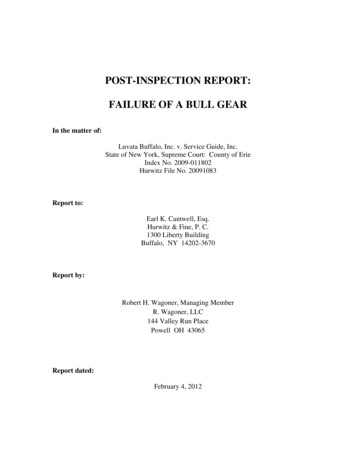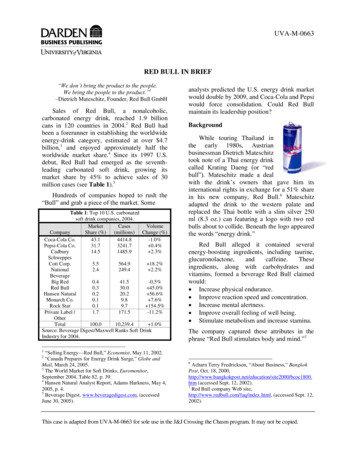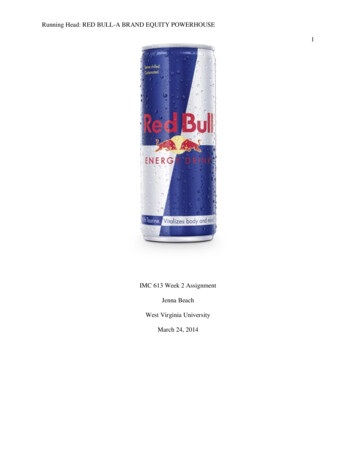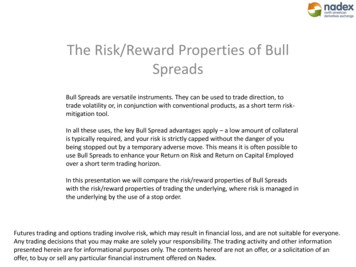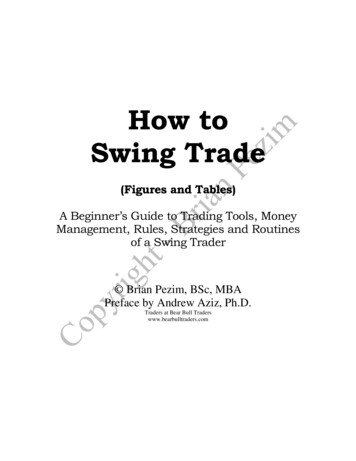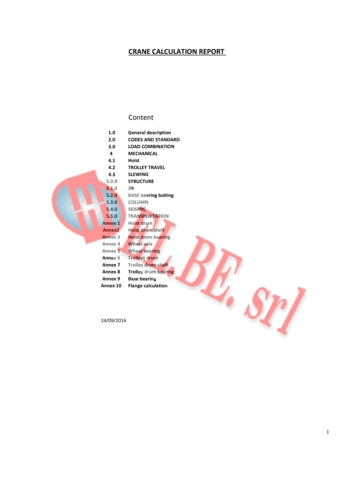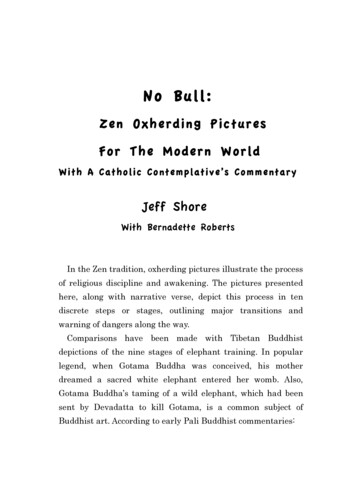
Transcription
No Bull:Zen Oxherding PicturesFor The Modern WorldWith A Catholic Contemplative’s CommentaryJeff ShoreWith Bernadette RobertsIn the Zen tradition, oxherding pictures illustrate the processof religious discipline and awakening. The pictures presentedhere, along with narrative verse, depict this process in tendiscrete steps or stages, outlining major transitions andwarning of dangers along the way.Comparisons have been made with Tibetan Buddhistdepictions of the nine stages of elephant training. In popularlegend, when Gotama Buddha was conceived, his motherdreamed a sacred white elephant entered her womb. Also,Gotama Buddha’s taming of a wild elephant, which had beensent by Devadatta to kill Gotama, is a common subject ofBuddhist art. According to early Pali Buddhist commentaries:
Just as a man would tie to a postA calf that should be tamed,Even so here should one tie one’s own mindTight to the object of mindfulness.The metaphor is an ancient one. In China and in much ofSoutheast Asia the farmer’s ox was a fitting choice of subjectsince it was necessary for his livelihood. When the ox is gone,what is most essential has been lost. Like a mother unable tofind her baby, or an American businessman who can’t findwhere he parked his car (with laptop and wallet inside), there isnot a moment’s rest until it is found.The ten paintings reproduced here are attributed to theJapanese Zen monk Shûbun, a fifteenth-century abbot of theShôkokuji Rinzai monastery complex in Kyoto and one of thegreatest painters of his age. Each picture is accompanied by twoshort verses attributed to Kuo-an Shih-yuan [Jp.: KakuanShion], a Chinese Zen monk of the Sung Dynasty. These verseshave become a standard text in the Zen tradition, and areincluded in the classic Four Texts of the Zen School [ZenshûShiburoku], and in the two-volume Poison-Painted Drum[Zudokko], the handbook for Rinzai monastic practice.The verses for each picture are written in classical Chinese.First there is a sort of prose poem, which sets the basic tone foreach picture. (Sometimes these have been attributed toKuo-an’s disciple Tzu-yuan [Jion], who wrote an introduction tothe ten oxherding pictures.) These prose poems are written in2
eight lines of verse, with the following number of Chinesecharacters for each line: 4, 4, 6, 6, 4, 4, 4, 4. Following eachprose poem is a four-line poem of seven characters each, evokingthe basic sentiment and fleshing it out, often with concretesights and sounds.The line scheme is maintained in the translation here – eachline of Chinese is rendered as one line in English. However, Ihave made no attempt to follow the rhyme scheme, let alone theparallelism, antithesis, tones and so on used in such verse. Thisis a retreat, not a conference or seminar; my focus throughout isto expose the marrow, which is often only suggested, so that youcan see through your self.Don’t worry about keeping track of the stages; just take ineach one as a whole. Don’t worry about where you are in thepictures either – the first one will do if you’re really there.Finally, the verse is terse and sometimes leaves unstated suchbasic components of syntax as subject, object and verb. I trustthe reason for my clumsy attempt to do this in English willbecome clear as the lectures progress in this, the year of the ox.KyotoSeptember 20093
1. Seeking OxNever gone astray –What need to search?By turning away from awakening, the split occurs:Covered in dust, finally all is lost.Hills of home ever more distant,Diverging paths proliferate:Flames of gain-loss,4
Blades of right-wrong.Wading through thick weeds, searching, searching.Rivers swell, mountains tower, paths unending.Exhausted, in despair, without a clue.Only the drone of cicadas in autumn leaves.The first two lines throw us right into the maelstrom: If it’snever gone astray, why search? If it ain’t broke, why fix it?Commentaries even today endlessly repeat that the young oxherder is you, the person seeking the Way, and the ox is yourtrue self, Buddha nature, the ultimate. But this is of little help.Who, after all, is the one seeking – and what, in the end, hasbeen lost? If you knew that, you really wouldn’t need to seek.Yet here you are, seeking. Until you’ve really struggled withthis and come to the end, to glibly say “It’s never gone astray,so I don’t need to search” is at best a half-truth, at worst aself-serving lie, isn’t it?Looking at the picture, it’s all eloquently expressed in thebearing of the farm boy-acolyte monk: Feet are carrying himoff in one direction, while head turns the other way. Split,within and without; doesn’t know whether he’s coming orgoing. Desperately searching – but no idea where to look.The first two lines have already revealed that originally –when and where is that? – there is no you here, no ox there.Then the third line states why, if you’re honest with yourself,you must seek, you cannot help but search: because reality has5
turned away from (literally: “due to turning back on”) itssource. Coming to my self, I divert, pervert, what originally nlightenment-illusion, birth-death, right-wrong, and so on.No reason is given for this original turning away. It issimply stated as a fact – a fact that each of us confirms in ourexperience of self.Do you see a connection with the Fall in the Book of Genesis,with Adam and Eve (i.e., all of us) turning away from God’scommand, thus opening their eyes and knowing they werenaked? In his Systematic Theology, Paul Tillich explains itthis way:The state of existence is the state of estrangement. Man is estrangedfrom the ground of his being, from other beings, and from himself. Man as he exists is not what he essentially is and ought to be. He isestranged from his true being.Tillich describes unbelief or “un-faith” this way: man in the totality of his being turns away from God. In hisexistential self-realization he turns toward himself and his world andloses his essential unity with the ground of his being and his world. Man, in actualizing himself, turns to himself and away from God inknowledge, will, and emotion.The rest of the text for the first picture details this split into6
within and without: Covered in the defiling dust of senseattachments (the five senses and mind), the all is lost. Thefurther I seek, the more paths proliferate, with no sign of thedesired object anywhere. At the same time, my home recedesfurther and further from view. Anxiety over gain and lossburns in my heart, dilemmas over what is right and wrongpierce my very soul.The four-line poem continues the imagery: stuck in the mudand weeds of delusive attachment, rivers overflow their banks,vast peaks threaten from above. All my energy spent, stuckbetween a rock and a hard place, an oppressive, monotonousdrone is all that the senses pick up.Jackson Browne’s classic rock anthem “Running on Empty”was recorded in 1977, a year after the suicide of his first wife:Looking out at the road rushing under my wheelsLooking back at the years gone by like so many summer fieldsIn sixty-five I was seventeen and running up one-o-oneI don’t know where I’m running now, I’m just running onRunning on – running on emptyRunning on – running blindRunning on – running into the sunBut I’m running behind .In sixty-nine I was twenty-one and I called the road my ownI don’t know when that road turned onto the road I’m on7
.Looking out at the road rushing under my wheelsI don’t know how to tell you just how crazy this life feelsI look around for the friends that I used to turn to to pull me throughLooking into their eyes I see them running too .You know I don’t even know what I’m hoping to findRunning into the sun but I’m running behindSound familiar? This is where the journey begins. For animportant discovery has already been made: I realize I havelost it. And in my restless seeking, I have become utterly lost.This is the point of the first picture, “Seeking Ox.”No longer feigning contentment with my discontent, Isincerely begin. I don’t pretend that the bull is in the barn;don’t divert my eye from the horns of the dilemma that I am. Ino longer delude myself with wishy-washy, half-baked notionsof delusion being enlightenment. I recognize how greedilyseeking some enlightenment experience that’s supposed tosolve all my problems is, indeed, a big problem. Instead of“Seeking Ox,” this first stage could be called “No More Bull.”In the 1946 film Song of the South, Brer Rabbit, wanderinghappily on a country trail, gets in a tussle with a tar baby – acouple of sticks covered in hot tar that resembles a human.Trying to get unstuck, Brer Rabbit ends up getting “so stuckhe can hardly move his eyeballs!”Profound and pervasive dissatisfaction is common at this8
point; whatever we encounter, that’s not it. As Paul Tillichsuccinctly put it: “Everything is tried and nothing satisfies.”Every path breaks into ever more trails, without a clue ortrack to follow. Each path taken seems endless – yet ends up adead end. The harder we try to find our way, the more lost weget. The first two noble truths of Buddhism manifest: blindcraving inevitably results in dis-ease. Pursued in all sincerity,great doubt arises, for self is this split, this separation. Thereligious quest is not in vain; at this point in the journey,however, it sure as hell can seem like it.The line “Flames of gain-loss” harks back to one of Gotama’sfirst and foremost teachings, known as the Fire Sermon. (T. S.Eliot, in a note to “The Fire Sermon” section of his 1922 poemThe Waste Land, goes so far as to state that this sermon“corresponds in importance to the Sermon on the Mount.”)Delivered to a group of fire-worshipping ascetics, Gotamaturns up the heat by stating that all is burning, all is ablazewith blind desire, self-centered delusion, dis-ease. Later wewill return to this sermon and see what Gotama’s got cooking.During the extremely hot and dry August of 1949, a firestarted in the mountains around Mann Gulch in centralMontana. A group of firefighters led by Wagner Dodge isparachuted into the area. Rugged mountains rise on both sidesof the valley. The fire is above them. In an emergency they cansafely retreat to the Missouri River at the bottom of the valley.The winds whip up debris, however, and a fire now startsbelow them, blocking the way to the river. Due to freak9
weather conditions, this fire quickly grows into an enormousroaring wall of flame racing toward them much faster thanthey can run. Virtually impenetrable mountain slopes on bothsides, fire raging above and below. Leader Dodge realizes theyhave not more than a minute or two before the inferno hitsthem.What does he do? What do you do when things get too hot?We will return to Wagner Dodge later. Now I will let you stewin your own juices, to confirm for yourself the first oxherdingpicture. Then it will be time for us to take up the secondpicture.10
2. Seeing TracesThrough sutras, the meaning is understood,Looking into the teachings, traces are found.It’s clear: various vessels are all one metal,All things are one self.But unable to tell right from wrong,How to discern the true from the false?Not yet having entered the gate,11
At least the traces have been seen.Tracks scattered all over the riverbank, under trees.Thick in sweet grass – Ah! What’s that?However deep in the mountain depths,Snout reaching heaven, nothing can conceal it.Look at the picture: head is screwed on straight now, bodyand mind unified, hand firm on the rope of discipline.What has happened? Tracks have been found! In the firstpicture there was not a trace. Now the tracks are all around.The first two lines credit the sutras and teachings, and such isoften the case. Many first find their feet through a sutra, a bookon Buddhism, or by encountering someone who has alreadymade the trek.Buddhist writings and Dharma encounters are indeedprecious, as are encounters with other religions. But where infact are the true teachings found? Keep heart and eye open.Coming into contact with the Dharma (living truth) is not justa matter of reading books, or listening to lectures – or evensitting in meditation. Dharma is not simply something you do.It must be what you are.Giving your self completely to proper and sustained practice,a thread is found; fashioning it into a rope, diligently follow. Thethird and fourth lines reveal that one thread runs through all,that “all things are one self” – what is that?Like the tracks themselves, the experience of this tends to12
remain a discrete event. So you’re not yet able to discern thewheat from the chaff, the true from the false, as the fifth andsixth lines demonstrate. To sum up the second picture: thediscrete tracks have clearly been seen, but the gate has not yetbeen entered.The four-line poem tells that traces abound. The entanglingweeds and mud have now transformed into sweet grass.Suddenly something stirs. Where is it? – Within? Without?Nowhere? Everywhere? We cannot lose sight of it again.Nothing can conceal what has been revealed. Whatever happensnow, we remain hot on the trail:I have often walked down this street before;But the pavement always stayed beneath my feet before.All at once am I several stories high.Knowing I’m on the street where you live.[“On the Street Where You Live” lyrics by Alan Jay Learner, My Fair Lady, 1964]In the Fire Sermon, Gotama described all as burning withdesire, delusion, and dis-ease. In following the Way, the sermoncontinues, I become disenchanted and then dispassionate of theall. (Do you see? This is not merely self, seeking an experiencethat will solve all its problems.) Then there can be full release.With full release there is direct knowledge of release, and onediscerns that this is the end of birth (and death), that the taskhas been done, that there is nothing further for this world. TheFire Sermon is a quintessential early Buddhist teaching of13
Nibbana [Skt.: Nirvana]: the flame of self extinguished.Is that the only approach though? What about thecontemplative consumed in the flame of God’s love, or theBodhisattva burning with compassion for all? RememberWagner Dodge? With the flames fast approaching and nowhereto escape, what did he do?First of all, he stopped running. That’s right, stopped in histracks. Have you? That is how to approach. By no longerrunning toward – or away from – anything, the tracks becomeclear. The way opens up underfoot. Strange as it sounds, if wedon’t stop, we can’t truly proceed.To stop is not merely to sit still. It is self, body-mind in itsentirety, all the senses, coming to a full and complete stop. Thisis the beginning of true zazen.Only when all running away – or toward – has ended, does itstart to become clear. True religious practice is not an escapefrom our problems, psychological or otherwise. See for yourself:trying to have it your way – or get a-way – only gets in the way,creates more entanglements. In proper and sustained practicelet it all go, once and for all. With this second picture, “SeeingTraces,” the right direction has been found.But the gate has not yet been entered. Be careful here.Consciousness can be clarified, purified, emptied to anincredible degree. This can be most helpful as a preliminarypractice. But that is far from the end of the matter. Learning tocoast and enjoy the ride for a while is not coming to a full andcomplete stop. A clarified, purified consciousness emptied of its14
Discrimination is not discernment. It is a discursive, relydiscrimination. It is seeing into, seeing through, the true natureof things. Buddhism warns against both “false discrimination”and “false sameness.” I leave it to you to discern the value of theso-called Zen, Buddhist, and other spiritual teachings floodingthe market nowadays. The poem for case twelve of The GatelessBarrier sums it up:Those who search for the Way do not realize the Truth,They only know their old discriminating consciousness.This is the cause of the endless cycle of birth and death,Yet ignorant people take it for the Original Man.Many so-called teachers reduce the problem to dualisticthought or discriminating intellect, and then offer ways to getrid of it – a sure sign that discrimination remains.Discriminating intellect is not the problem; it is merely the tipof the iceberg. As Paul Tillich already made clear, estrangementconcerns “knowledge, will, and emotion.” Whether thinking,willing, or feeling, self-as-consciousness is split. Do suchteachers even recognize the real problem underfoot?Don’t mistake the footprint for the beast. Once you havestopped, that which is sought in all sincerity shows the way.The tracks unmistakably show the direction you must go.In your practice, patiently gather all your energy into one. As15
you do, the activation of the senses (including mind) is not onlyclarified, purified, and emptied; it is suspended. The sensesfunction during daily activities. In sustained zazen also, thesenses are completely open – yet held in check, so to speak. Asthe technical Buddhist expression puts it, there is no “outflow”[Skt.: âsrava; Pali: âsava] – or inflow. Now we are ready for thethird picture.16
3. Finding OxBy listening, an entrance found;Seeing through, the source encountered.It is this way with all six senses,Every act crystal clear.Like salt in water,Or glue in paint.Open your eye:17
There’s nothing else.Nightingale singing, singing in the treetops.Warm sun, soft breeze, riverbank willows green.Right here, nowhere to run, nowhere to hide.Majestic head and horns no artist could capture.The first line harks back to picture two and gaining a footholdthrough such things as hearing the teachings. In earlyBuddhism, hearing the Dhamma [Skt.: Dharma], considering it,and practicing it were called the three wise ways. In ancienttimes the Dharma was not written down but orally recited andmemorized. Thus hearing it was the natural first step. In time,reading became more common, so we don’t need to cling to theauditory sense. Actually, the entrance is everywhere, filling allour senses, if only we are in tune, in accord. The sustained effortof gathering all into one culminates in realizing all is one. Now,where does that come from?Look at the picture: for the first time the ox has appeared.With the second line, we plunge right in. This is no longercatching sight of discrete tracks, or hearing something in thedistance. Entering the source itself, it’s “here” without a doubt.Not a sound, sight or insight, but the root-source of experience.This is not a discrete experience that self can have, howeverwondrous.The third and fourth lines make clear that encountering theroot-source transforms all the senses: seeing, hearing, smelling,18
tasting, touching, and mind are now clear and unhindered intheir functioning. The rest of the first verse reveals that all isnow inseparable from the source itself: salt in water, the glue inpaint suggests that the source is there “in” each and every thing,but inseparable. The source is not simply something else,something other.Poet-layman Su Tung-po of eleventh century China expressedit as: “Gurgling brook the gold, broad tongue; are mountaincolors not the pure body?” Every sound, the eloquence ofBuddha; every form, the body of awakening.The four-line poem for picture three sings and portrays thatwhich is beyond sound and sight. The source is apparentwherever we look, whatever we hear or think or feel: “rocking inthe treetops, all the day long,” “nowhere to run to, nowhere tohide.”The last line of the four-line poem suggests that although it isfully expressed in – as – each and every thing, the source isinexhaustible. That which you have sincerely sought andfaithfully followed, draws you in and shows the way. The livingsource which cannot be objectified or separated out – but whichyou now know you are inseparable from – will not lead youastray. Only you can do that. Like gravity inevitably drawingyou in: resist and you’re left sucked into the vacant center ofyour “self” instead of being drawn inevitably into the source ofall.After the Edo Period Zen master Hakuin Ekaku had his firstsight of the ox, he was asked about “Mu” or emptiness. He19
replied “No place to lay hand or foot on that.” A naturalresponse at this stage, though we will return to it later.We left Wagner Dodge stopped in his tracks. As important asthis stopping is, it is not enough. The flames still approach.There is one more thing Wagner Dodge did. It seemed so bizarrethat most of the others in his crew thought he had gone crazy, sothey continued running. As a result, they died. After he stopped,what did he do?He lit a match. Burning the grass around him, he then laydown in the burned patch and escaped unscathed.We are not fire fighters. But we, also, stop running. Andinstead enter the flames.In religious practice, what remains, what survives, after allhas been consumed? Put the other way around: when one hasbecome disenchanted and dispassionate with all, who realizesrelease, for whom does the flame become extinguished? Onlyafter all has been consumed can this really be known. It is nowtime to turn to picture four.20
4. Catching OxLong hidden in wilderness,Today finally found.Yet hard to keep up with it wandering off:Longing for meadows of sweet grass,Refusing to be broken,Wild as ever.To bring into complete accord,21
Lay on the whip!Putting all energy into it, grab the beast.Yet so strong and stubborn, won’t be broken.Now taking the high ground.Now descending into misty depths.If the ox is our so-called true self, the absolute, Buddhanature, why must it be broken and tamed?At any rate, you need to be firm here. Don’t ease up. As it’ssaid: “The further you go, the deeper it gets; the more yourealize, the harder you must strive.” With your whole being,grab the bull by the horns and don’t let go!As the picture shows, the two are not yet completely one. Butthey are inseparable now. Be careful when discord arises; do notfall back into old ways. As the last two lines of the second versesuggest, one moment you will be taken to the very summit, thenext plunged into the very depths.Constant practice of right effort, with great trust, is requiredhere. To really grab the bull by the horns with your whole being,you must let go of all your hopes and expectations, all yourexperiences, knowledge and insight. Such things preventcomplete accord. You can’t have this on your own terms. Simplycontinue on, without desire or complaint.Remember Hakuin? Asked by the master about “Mu,” heproudly responded: “No place to lay hand or foot on that.” A fineanswer, clearly displaying the young Hakuin’s spiritual prowess22
and freedom. The master, however, exposed the place whereHakuin was still bound to his freedom by promptly squeezingHakuin’s nose and declaring, “Got a pretty good hand on it here.”Then with a hearty laugh, the master spat out: “You poorhole-dwelling devil!”Indeed. If any such place remains in you, don’t wait for me tosmash it. Don’t get attached to it, don’t dwell or abide in it.Don’t turn it into an experience you have attained: “ man mustbe so poor that he is not and has no place wherein God could act.Where man still preserves some place in himself, he preservesdistinction. This is why I pray God to rid me of God ” MeisterEckhart. Don’t get caught by the bull of your experience,however subtle or profound.23
5. Taming OxOnce a thought arises,Another surely follows.Wake up and all becomes truth,Abide in ignorance and all is false.This is not due to external conditions,It arises from mind.Hold tight the rope,24
Do not waver.Don’t let go the whip and tether even a moment,Or alas, the beast may wander into worldly dust.Properly tend till tame and gentle,Without entangling bridle, following of its own accord.As the picture shows, they now move as one. There is littleresistance anymore. The going is smooth.However, the text warns of remaining dangers. Having comethis far, you might wonder how could there still be obstructions?To the question: “But after kenshô [i.e., the initial experience ofseeing the true nature] is attained and you have entered thepath of enlightenment, surely there’s no evil to obstruct youthen?” Hakuin answers: “Indeed there is! It exists if you createit. If you don’t create it, it doesn’t exist. But such distinctionscan wait until after you’ve attained the Way. You can pose suchquestions to yourself then – it won’t be too late.”A stubborn illness requires bitter medicine. So the text forpicture four stated: “To bring into complete accord, lay on thewhip!” Here the tone is a bit different: “Hold tight the rope, donot waver.” The text here concludes: by proper tending, followsof it own accord, with no more need for implements or prodding.Here it is confirmed that this “practice” is not something youdo at times, for example, on the zazen cushion. It is constant; itis what you are. Still, you must take great care not to sully ordefile it.25
We are now halfway through the journey. You have gotten asense of the “process,” skillfully but artificially broken up hereto help us on the Way. I trust you now see there are not reallyten discrete steps or stages. Zen is not preoccupied with processor even transformation. Don’t get hung up with this portrayal ofthe stages, or the accompanying narrative. Everyone must gothrough themselves; no two paths will be the same. Thesedepictions and descriptions can be helpful signposts and warnus of traps along the Way. The point, however, is to actuallycomplete the journey.While each one must make the journey themselves, as a grouppracticing together, let us all continue on the Way, supportingeach other and being supported by each other. Determined butpatient. Through day and night, pleasant and unpleasant,bearable and unbearable, illusion and enlightenment. Don’tstop halfway.26
6. Returning Home Riding OxThe struggle is over;Loss-gain vanished.Humming rustic tunes,Playing a child’s ditty.Astride the ox,Gazing at boundless sky.Even if called, won’t turn round,27
Though enticed, will not stop.Astride ox, leisurely wending the way home.The tune dissolves evening glow.Sentiment unbound in each beat and verse.In tune with each other – need it be said?With this sixth picture the struggle has ended. The dis-easedsubject is no more. Boundless child playing boundless tunesastride boundless ox gazing at boundless sky. This is perhapsthe most famous of the oxherding pictures, similar to Taoistdepictions of Lao Tzu riding off into the mountains astride anox.Picture and verse express a profound samadhi-at-play, orjoyful samadhi, free of self-other. No need for complexphilosophies, a simple song says it all:Mr. Bluebird’s on my shoulder;It’s the truth, it’s actual –Everything is satis-factual!”[“Zip-A-Dee-Doo-Dah” lyrics by Ray Gilbert, Song of the South, 1946]Not a worry in the world. Who needs outside confirmation,lineage or ruitionineffortlessness. Tao Te Ching (chapter 48) and Chuang Tzu(chapter 22) speak of “Doing nothing – yet nothing is left28
undone.” Nothing is easy. This is really running on empty. Inthe beginning, each path led to a dead end; now, every roadleads home.Who is in tune with whom? As the end of the text for picturesix suggests, to those who are truly intimate, what words arenecessary, what praise possible? The Tang Dynasty monkLin-chi [Jp.: Rinzai], the father of Rinzai Zen, demands “Speak,speak!” He is not asking for words.“Returning Home Riding Ox” is a marvelous moment on theWay. But there is still a ways to go.29
7. Ox Forgotten, Man RemainsThere are not two Dharmas,And the ox is symbolic.The trap is left when the rabbit is snared,The net abandoned once fish are caught.Like gold from dross,Or moon emerging from clouds:The single beam shines30
Prior to the world arising.Astride the ox, the hills of home at last.Ox vanished, you’re at ease.Sun already high in the sky, yet dream on.Rope and whip idly lie under thatched roof.The ox is gone – again! But unlike the first (and second)pictures, now there is no need to search for it. It will notreappear; even its troublesome tracks have vanished. No bull –another marvelous moment on the Way.The person remains – yet he is not the child that began thejourney. This “one” is inseparable from all. The picture showshim spontaneously bowing and putting hands together ingrateful prayer. To whom or what, you might ask. But once weget here, the question answers itself; such bowing is the answer.Still, there is value in sincerely asking.As the text reveals, here there are not dual Dharmas: noconflicting truths, nor levels of reality. There’s not really oneeither.Separating gold from dross, moon emerging from clouds,suggests that what we desperately sought has always been here– but must be realized. The ox never has gone astray – once weactually stand here, that truth is manifest. And so the ox,having done its work, is gone.The single beam that is shining refers not only to the moon’senlightening glow; if it did, how is it prior to the world arising?31
Sun already high in the sky, yet dreaming on: the peacefulslumber of awakening. Consider: “Samsara [birth-death] as wellas Nirvana – like last night’s dream.” Or the Taoist expression“Sleep without dream and wake without care.” Can you evenremember the first picture, where you couldn’t find a moment’srest?The implements you had used to tame and train are now idle,as trap and net are left once the creature is caught. The waysand means must be mastered – then abandoned. Don’t let waysget in the way, don’t turn the practice into the service of the self:“Whoever is seeking God by ways is finding ways and losingGod, who in ways is hidden.” Meister Eckhart. Amen.What remains here? This alone, without object – or subj
In the Zen tradition, oxherding pictures illustrate the process of religious discipline and awakening. The pictures presented here, along with narrative verse, depict this process in ten discrete steps or stages, outlining major transitions and warning of dangers along the way


